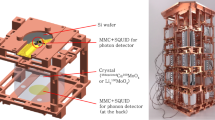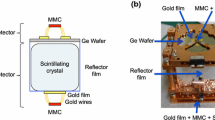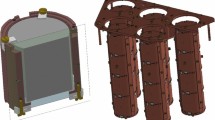Abstract
The MOON (Majorana/Mo Observatory Of Neutrinos) project aims at studies of the Majorana nature of the neutrino (ν) and the ν-mass spectrum by spectroscopic experiments of neutrino-less double beta decays (0νββ) with the ν-mass sensitivity of 〈m m ν 〉 = 100−30 meV. The solid scintillator option of the MOON detector is a super ensemble of multi-layer modules, each being composed by PL scintillator plates and position-sensitive detector planes with good overall energy resolution of σ ≈ 2% at the Q ββ ≈ 3 MeV. Thin ββ source films are interleaved between the detector planes. High localization of the two β tracks enables one to select true signals and reject BG ones. The multi-layer structure of the detector makes it realistic to build a compact ton-scale detector. MOON with detector ≠ ββ source is used for studying 0νββ decays from 100Mo, 82Se and other ββ isotopes with large Q ββ . Real-time exclusive measurements of low energy solar neutrinos can be made by observing inverse β rays from solar-ν captures of 100Mo in delayed coincidence with the subsequent β decay of 100Tc.
Similar content being viewed by others
References
H. Ejiri, J. Phys. Soc. Jpn. 74, 2101 (2005); H. Ejiri, Prog. Part. Nucl. Phys. 57, 153 (2006)
J.D. Suhonen, O. Civitarese, Phys. Rept. 300, 123 (1998)
H. Ejiri, Phys. Rept. 338, 265 (2000)
J. Vergados, Phys. Rept. 361, 1 (2002); J.D. Vergados (2007) (private communication)
F. Simkovic, A. Fassler, Prog. Part. Nucl. Phys. 48, 201 (2002)
F. Avignone, S. Elliott, J. Engel (2007) [arXiv:nucl-exp/0708 1033v1]
H. Ejiri, et al., Phys. Rev. Lett. 85, 2917 (2000)
H. Ejiri, Czechoslovak, J. Phys. B 54, 317 (2004); 56, 459 (2006)
H. Ejiri, Mod. Phys. Lett. A 22, 1277 (2007)
C.E. Aalseth, et al., Yad. Fiz. 67, 11 (2004)
S. Scheonert, Proc. Neutrino Santa Fe, 2006
E. Fiorini, Proc. ICNP Tokyo, June 2007
A. Piepke, Proc. Neutrino Santa Fe, 2006
K. Zuber, Phys. Lett. B 519, 1 (2001)
G. Bellini, et al., Eur. Phys. J. C 19, 43 (2001)
F. Piquemal, Proc. TAUP Sendai, Japan, 2007
N. Ishihara, et al., Nucl. Instrum. Meth. A 443, 101 (2000)
H. Ejiri, Eur. Phys. J. Special Topics 162, 171 (2008); Proc. SPIN07 Prague, 2007 (to be published)
H. Ejiri, et al., Nucl. Instrum. Meth. Phys. Res. A 302, 304 (1991); H. Ejiri, et al., Phys. Lett. B 258, 17 (1991)
H. Ejiri, et al., Phys. Rev. C 63, 065501 (2001)
O. Civitarese, J. Suhonen, Nucl. Phys. A 729, 867 (2003)
V.A. Rodin, et al., Nucl. Phys. A 766, 107 (2006) [arXiv:nucl-th/0706.4304] (2007)
N. Kotelainen, J. Suhonen (2007) [arXiv:0708.0115v1] [nucl-th]; [nucl-th/0705.0469]
R. Arnold, et al., Phys. Rev. Lett. 95, 182302 (2005)
R.J. Gaitskell, 3rd Int. Workshop Identification of Dark Matter (World Scientific, September, 2001) [arXiv:astro-ph/0106200]
P. Doe, et al., Nucl. Phys. A 721, 517c (2003)
M. Nomachi, et al., Nucl. Phys. Proc. Suppl. 138, 221 (2005)
T. Shima, Proc. TAUP07, Sendai, 2007
H. Ejiri, et al., Proc. TAUP07, Sendai, 2007
H. Nakamura, et al. (2008) (submitted)
H. Nakamura, et al., J. Phys. Soc. Jpn. 76, 114201 (2007)
J.N. Bahcall, et al., Phys. Lett. B 433, 1 (1998), and references therein
H. Ejiri, J. Engel, N. Kudomi, Phys. Lett. B 530, 27 (2002)
Author information
Authors and Affiliations
Corresponding author
Rights and permissions
About this article
Cite this article
Ejiri, H., Doe, P., Elliott, S.R. et al. MOON for neutrino-less double beta decays. Eur. Phys. J. Spec. Top. 162, 239–250 (2008). https://doi.org/10.1140/epjst/e2008-00799-2
Published:
Issue Date:
DOI: https://doi.org/10.1140/epjst/e2008-00799-2




